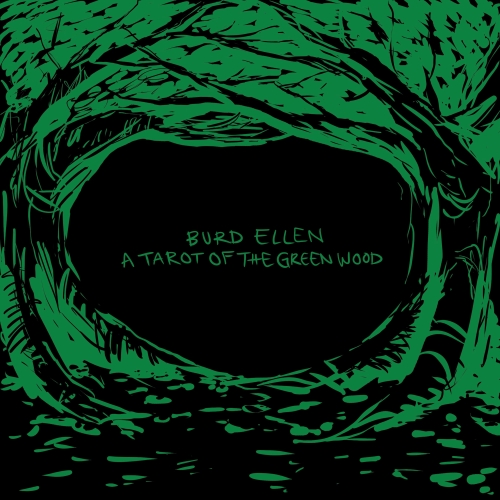|
(2022) Burd Ellen - A Tarot of the Green Wood
Review:
Something about Burd Ellen’s eerie take on drone-heavy, experimental folk is uniquely suited to the crepuscular nooks of the year, the times of seasonal change when the cast of a landscape changes almost imperceptibly or the quality of light shifts ever so slightly. In 2020 the duo – Debbie Armour and Gayle Brogan – released their second album, Says the Never Beyond, which dealt exclusively with the chilly charms of winter. Its follow-up, A Tarot of The Green Wood, is wider in scope and more unconventional in theme but still manages to convey the slow passage of time and the weird weight of the history of these isles. It takes the form of a set of musical tarot cards: the pair use the Major Arcana as a starting point from which to explore folkloric imagery and traditional song. The basis of tarot is the idea of finding meaning in the arcane, interpreting something that is obscure in order to make something clear. Those shifting borders between clarity and obscurity are present everywhere in Burd Ellen’s music. Six of the seven tracks are traditional, but they are tweaked and lightly jostled into uncanny hinterlands by means of Armour’s high, eldritch singing, Brogan’s unexpected musical interventions and that characteristic drone. The judicious use of double-tracked vocals lends a fleeting, spooked echo to a tiny snippet of opener The Fool, a song well-known in trad circles as Over The Hills And Far Away. The lyrics, dealing in part with the folly of armed conflict, are from 1706. That gap of three centuries tells us that human nature is very difficult to change. The High Priestess & The Hierophant is based on Fair Annie, and its themes of subjugation, sorority and emancipation, like many of the themes in folk songs, are resonant to this day. The music here is stark, and uncomforting – it conjures a harsh landscape which in this case could be emotional as much as physical, a fitting setting for a narrative in which the female protagonists face a bleak situation with courage and intelligence. The song is well-known in the Scottish tradition (and well-suited to Armour’s Scottish accent) but originally came from France, possibly more than 800 years ago. That contrast between ancientness and contemporary relevance nestles like a spell in the song’s heart, contributing to its strangeness. The Lovers begins minimally, with eerie plinks initially the only thing backing up Armour’s singing. Dark, cavernous effects build as the melody seems to grope insistently in the dark. Halfway through, the music drops out entirely, and Armour’s voice is backed by field recordings – strange avian calls and the white noise of running water. There is a sense of peace and lightness, but its sudden onset is uncanny, and the whole thing has a wonderfully elemental feel to it. The Chariot (known to many as When I Was On Horseback) somehow takes this feeling even further. At a shade under ten minutes, it has the feel of a journey. Possibly, given the song’s subject, the journey in question is the one that involves crossing the border between life and death. As the song progresses, the electronic effects and manipulated vocals become more woozy, haunting chimes pierce the gloom. Ian Lynch from Lankum adds a nagging accompaniment on pipes while Armour’s words flit in and out as if on the edge of consciousness. Brogan’s synthesised zips and flashes come to the fore on The Hermit, in which the myth of Orpheus and Eurydice is transplanted to the fairy kingdom, while the minute-long Death is perhaps the greatest surprise, dispensing altogether with musical backing in favour of three human voices: Armour and Brogan are joined by guest Mark Wardlaw, and the result is an intense and moving interlude. The final track is the album’s only non-traditional piece, a version of Alasdair Roberts’ Under No Enchantment. Armour has worked with Roberts in Green Ribbons, and here she helps turn his song into a near-fifteen-minute epic. It starts simply enough: a pretty melody, muted keys. A scratchy, keening fiddle introduces the first elements of discord before the now-familiar drone and echo-laden vocals kick in. There are moments of near-silence, strange scrapes, periods of contemplation or stark self-doubt. This is music perfectly attuned to Roberts’ beguilingly oblique lyrics, which themselves seem to tie in with the myth and obscurity and unique cosmogony of the tarot. There are countless different tarot decks in existence, and each has its own mythology, its own way of being interpreted or resisting interpretation, so much so that divination could be described as a form of artistic expression, one with deep historical roots and complex layers of meaning. A Tarot Of The Green Wood adds to that artistic tradition in a unique way, exploring shared archetypal imagery in a successful attempt to tread entirely new ground. It is a suitably bewitching, disconcerting and often profoundly moving experience from the most innovative duo in folk music. — Folk Radio

Track List:
01. The Fool
02. The High Priestess & The Hierophant (Album Version)
03. The Lovers
04. The Chariot
05. The Hermit
06. Death
07. Under No Enchantment (The Star & The Moon)
Media Report:
Genre: alternative folk, british folk
Country: Glasgow, UK
Format: FLAC
Format/Info: Free Lossless Audio Codec
Bit rate mode: Variable
Channel(s): 2 channels
Sampling rate: 44.1 KHz
Bit depth: 16 bits
Compression mode: Lossless
Writing library: libFLAC 1.2.1 (UTC 2007-09-17)
Note: If you like the music, support the artist |

